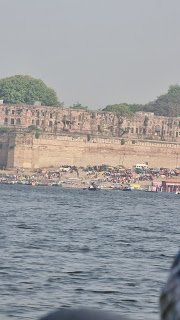Snan & Triveni Sangam
Sangam & The Sanam
Scriptures says that a Snan is Triveni Sangam dissolves all the Paap that is in your credit.
And that’s the first thing we did in the morning leaving the hotel by 5.30 reached the ghat. Had super hot and freshly made Chai and proceeded in two boats to where the White Ganges meets the Green Yamuna and the invisible Saraswathi to form the mighty Ganges which flows into Kasi, Bodh Gaya and then on to West Bengal to join with bhramputra and flow into the Bay of Bengal
From the Yamuna ghat side you need to take a boat ride to the Sangam ( where you can see the calm Yamuna merging with the fast Ganga. At that place boats are stationed and the water level is around 4 ft. From the boat you transfer to another stationary boat where a pandit does the sangalpam and then you get into the water to have the holy dip. During sangalpam you need to gave a coconut and a small red cloth flowers turmeric powder and kumkum and a coin. Getting down during the dip leave this in the river. You pay the pandit any amount starting from rs 200 to rs. 500. People are enterprising enough to sell you emotions asking you to offer 100 200rs(which they keep it ready and ask uou to put it into the water and they keep their hand inside the water so you actually handover it to them. Then there is another person holding watery milk giving uou a cup asking you to pour into the river and later asks you 100 or 200 or 500 for it.
you fill the water can with Ganga Jal and bring it back with you in all reverence.
the wet clothes are changed in the boat itself with your family or friends holding old saree Dhoni as a temporary curtain.
Then you get on to your waiting boat to return to the land.
so it is Ganga Yamuna Saraswati Maata ki Jai.
here is the official writeup
Triveni Sangam is the confluence of the Ganges (Ganga), Yamuna, and the mythical Sarasvati River. Triveni Sangam is located at Prayag – the area of Prayagraj neighbouring the confluence; for this reason, the confluence is also sometimes referred to as Prayag.The Ganges and Yamuna there can be identified by their different colours – the water of the Ganges is clear while that of Yamuna is greenish in colour.[6] The third river, mythical Saraswati, is called invisible. The auspiciousness of the confluence of two rivers is referred to in the Rigveda, which says, “Those who bathe at the place where the two rivers, white and dark, flow together, rise up to heaven.
It is located about 7 km from Civil Lines, overlooked by the eastern ramparts of the Akbar Fort.
Wide flood plains and muddy banks protrude towards the sacred Sangam. At the mid-river point priests perch on small platforms to perform puja and assist the devout in their ritual ablutions in the shallow waters. A dip in the Sangam water is supposed to be the holiest of the holy pilgrimages for the devout Hindu. Boats to the Sangam can be rented by pilgrims and tourists alike at the ghat near the fort. It is during the Maha Kumbh/Kumbh that the Sangam truly comes alive, attracting the devout from all across the country.
A place of religious importance and the site for historic Kumbh Mela held every 12 years, over the years it has also been the site of immersion of ashes of several national leaders, including Mahatma Gandhi in 1949
Kumbh Mela and Sangam
According to legends, Vishnu was carrying a Kumbh (pot) of amrit (nectar), when a scuffle broke out and four drops were spilled. They fell to earth at the four Tirthas of Prayag, Haridwar, Nasik and Ujjain. A tirtha is a place where the devout can attain salvation. The event is commemorated every three years by the Kumbh Mela, held at each tirtha in turn; the Sangam is known as Tirtharaj, the ‘King of Tirthas’ and here the Kumbh is held once in every twelve years, which is the greatest and holiest of all.








Comments